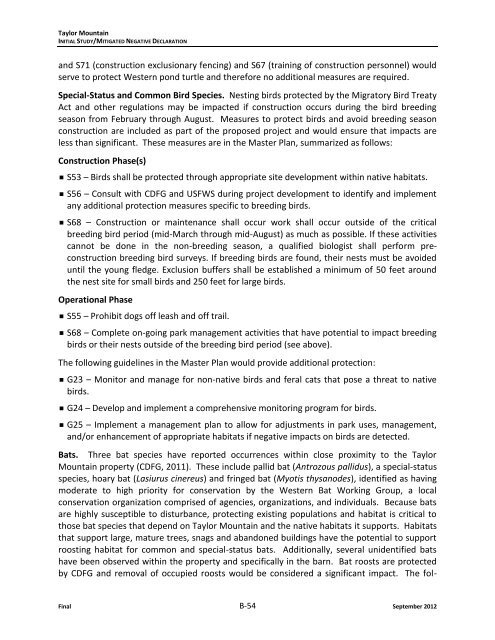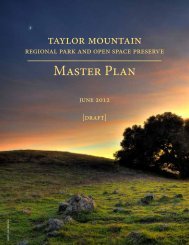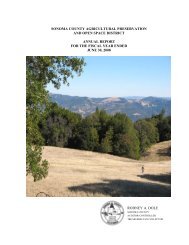Initial Study MND - Sonoma County Agricultural Preservation and ...
Initial Study MND - Sonoma County Agricultural Preservation and ...
Initial Study MND - Sonoma County Agricultural Preservation and ...
You also want an ePaper? Increase the reach of your titles
YUMPU automatically turns print PDFs into web optimized ePapers that Google loves.
Taylor MountainINITIAL STUDY/MITIGATED NEGATIVE DECLARATION<strong>and</strong> S71 (construction exclusionary fencing) <strong>and</strong> S67 (training of construction personnel) wouldserve to protect Western pond turtle <strong>and</strong> therefore no additional measures are required.Special-Status <strong>and</strong> Common Bird Species. Nesting birds protected by the Migratory Bird TreatyAct <strong>and</strong> other regulations may be impacted if construction occurs during the bird breedingseason from February through August. Measures to protect birds <strong>and</strong> avoid breeding seasonconstruction are included as part of the proposed project <strong>and</strong> would ensure that impacts areless than significant. These measures are in the Master Plan, summarized as follows:Construction Phase(s) S53 – Birds shall be protected through appropriate site development within native habitats. S56 – Consult with CDFG <strong>and</strong> USFWS during project development to identify <strong>and</strong> implementany additional protection measures specific to breeding birds. S68 – Construction or maintenance shall occur work shall occur outside of the criticalbreeding bird period (mid-March through mid-August) as much as possible. If these activitiescannot be done in the non-breeding season, a qualified biologist shall perform preconstructionbreeding bird surveys. If breeding birds are found, their nests must be avoideduntil the young fledge. Exclusion buffers shall be established a minimum of 50 feet aroundthe nest site for small birds <strong>and</strong> 250 feet for large birds.Operational Phase S55 – Prohibit dogs off leash <strong>and</strong> off trail. S68 – Complete on-going park management activities that have potential to impact breedingbirds or their nests outside of the breeding bird period (see above).The following guidelines in the Master Plan would provide additional protection: G23 – Monitor <strong>and</strong> manage for non-native birds <strong>and</strong> feral cats that pose a threat to nativebirds. G24 – Develop <strong>and</strong> implement a comprehensive monitoring program for birds. G25 – Implement a management plan to allow for adjustments in park uses, management,<strong>and</strong>/or enhancement of appropriate habitats if negative impacts on birds are detected.Bats. Three bat species have reported occurrences within close proximity to the TaylorMountain property (CDFG, 2011). These include pallid bat (Antrozous pallidus), a special-statusspecies, hoary bat (Lasiurus cinereus) <strong>and</strong> fringed bat (Myotis thysanodes), identified as havingmoderate to high priority for conservation by the Western Bat Working Group, a localconservation organization comprised of agencies, organizations, <strong>and</strong> individuals. Because batsare highly susceptible to disturbance, protecting existing populations <strong>and</strong> habitat is critical tothose bat species that depend on Taylor Mountain <strong>and</strong> the native habitats it supports. Habitatsthat support large, mature trees, snags <strong>and</strong> ab<strong>and</strong>oned buildings have the potential to supportroosting habitat for common <strong>and</strong> special-status bats. Additionally, several unidentified batshave been observed within the property <strong>and</strong> specifically in the barn. Bat roosts are protectedby CDFG <strong>and</strong> removal of occupied roosts would be considered a significant impact. The fol-Final B-54 September 2012







